Silver Street Owner Stories
Silver Street Owners’ Stories
This page is devoted to all the Silver Street owners who have contacted me via this website. Your Silver Street stories belong here!
Check out the amazing creation below! This metal Silver Street Tribute Sign was created by Larry in Michigan. The inspiration came from Larry’s brother Tim, a dedicated Silver Street fan and collector. Tim’s Silver Streets can be seen on various pages of this website.

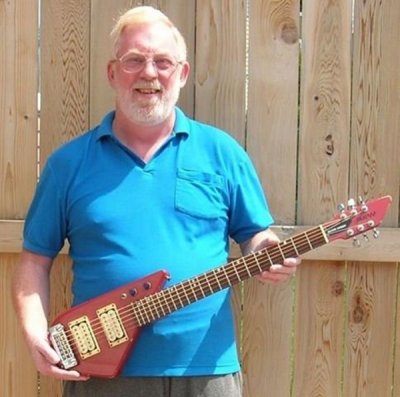
I’m the guy behind SilverStreetGuitars.com; the only online info source for Silver Street guitars.
My interest in these instruments began two decades ago. I spotted an ad for a TAXI on Craigslist and it became my first Silver Street. I was impressed by its innovative design and the quality of its components and construction.
As the years passed, I found additional Silver Streets and built a collection. Most owners I met lamented the absence of an info source for these interesting guitars. As a result, in 2010, I created the first rudimentary SilverStreetGuitars.com website. In 2012, I designed a larger and better organized site. In 2019, the website was expanded again and rebuilt on a new WordPress platform. I will continue to update the pages as new information is received from fans and owners.
SilverStreetGuitars.com would not exist without the images, information and advice provided by former Silver Street Inc. employees and Silver Street owners in the USA, Australia and Argentina. I am grateful for all their help. Every Silver Street guitar has an interesting backstory! Murray
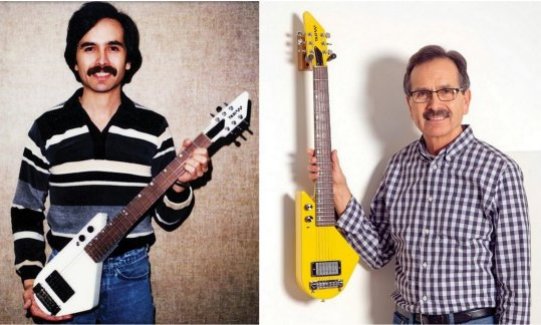
The long and winding musical road I have taken started with two years of classical piano, three years on a coronet in High School band and the bass guitar, inspired by seeing the Beatles on The Ed Sullivan Show. I had to get a band together and no one wanted to play bass…. so I took it up. My Junior and Senior years were foundational to my future career in the music industry. Fast forward to 1979. I have a band in my home basement on Silver Street in Elkhart. I am now playing guitar. I had a 63 Strat and a Dean ML. We were writing original music. My drummer, Brent Kreighbaum, who later became my general manager at Silver Street, had a great kit but it just didn’t sound right. My neighbor was a drummer too and his bass drum had a sheet of foam rubber that wound around the inside of the shell and touched both heads at the outer perimeter. It sounded killer!
At that time, I was working in an RV factory that constantly threw away one-inch foam. I had an idea, what if I cut out a donut shape and glued them on the inside of the bass drum head. I had two pizza tins and cut out the foam and, using a spray contact glue, put one each batter drumhead of Brent’s kit. WOW! At first Brent freaked out because he had just bought the heads. When he played them, he was convinced that this was a great idea.
I knew that I had a great idea that would work on all drumheads to muffle the tinny ring and was at my brother Craig’s home a few weeks later. I told him about the product and said I was going to approach Remo Belli. Quick Note: Craig had been our drummer in our high school band. Well, Craig said he wanted to form a company around the idea. He said, we can call it Silver Street Inc. He gave me a check for $10K and we were off to the races. We built a really cool soundproof room for our exhibit booth that allowed drummers to play a full TAMA kit and hear the Deadringer in action.
We went to the winter NAMM in Anaheim that year and got endorsements from Billy Cobham and Steve Smith who had just joined Journey. A full-page ad in the Musical Merchandise Review launched Deadringer and gave us heavy dealer acceptance. I have always been creative and, as they say, necessity is the mother of invention: Next came the original microphone stand mounted guitar pick holder: Pick-Clip, Headkeeper, The Imposter, Stick-em, Hot Pad, Keyp-It and Cable-Clip. I received 10 patents during my tenure at Silver Street which I assigned to the corporation.
In a year and a half the company grew rapidly. We sold to over 1100 dealers in the USA, shipped to distributors like St. Louis Music, C Bruno & Sons, Harris-Teller and more. We also had distributors in Australia, Canada, South America, Italy, Germany, France and Japan. Because of all this growth, my brother Craig decided to get a new building built for Silver Street. Needless to say, it was a very busy year for all of us!
As a result of a trip to the Music Messe in 1981, I came up with the design for the TAXI after seeing a few full-scale small body guitars in Frankfort. TAXI was a full-scale guitar that fit in a gig bag and could easily be transported in a Taxicab. The prototypes were built by luthier Richard Schneider who was a Kalamazoo, MI resident and a Gibson guitar consultant. He was a wonderful soft-spoken man that understood my vision and delivered giving us great prototype necks and bodies to take to the next NAMM show.
I decided to use quality parts such as Dimarzio pickups, Gotoh tuners. Bourns pots, BadAss and Schaller bridges and GHS strings. Marty Friend painted the prototypes their wonderful TAXI Yellow. Bill Alwine and I were up until 1 am the day of the NAMM Chicago show assembling and installing all the parts to the prototype guitars. A friend of mine, Ed Wilsey, flew me to Meigs Field near McCormick Place just in time to get the guitars to our booth for the opening.
After that summer NAMM in Chicago of 1982, we were now faced with filling orders. I had approached Jim Deurloo at Gibson earlier, he had connected me with Richard Schneider. Gibson was slowly closing down the Kalamazoo Parson Street Facility and moving production to Nashville. The mill however was still in operation, so we purchased around 100 bodies and necks for TAXI, approximately 50 of the SPIRFIRE and COBRA and 10 MX models to give us time to tool up our factory for production.
The necks were Les Paul profile with our signature headstock and the bodies were hard rock maple. The COBRA was what I would call an expanded TAXI in triangle form. The SPITFIRE was a mini cutaway, and the MX was a full-size Explorer/Flying V combination. We offered lots of metallic and solid colors, along with pearl, candy apple and flip flop finishes. I got to paint quit a few.
We were fortunate to have several artists use our products and play our guitars on stage and television. I would like to share a few stories regarding the TAXI and SPITFIRE guitars used by artists. David Huff of David and the Giants ordered a white pearl SPITFIRE. He sent me a handwritten letter thanking me and said that he was so impressed with it that he was taking it into the studio to record with it. Rick Springfield purchased three guitars. The Gold Top double pickup TAXI we built for him was used in an MTV video “Rock of Life”. I met up with him at a gig in South Bend, and he told me that he liked that TAXI so much that he wrote songs on the tour bus with it.
All of us at Silver Street were proud to build quality guitars that not only looked cool but also sounded good enough to record and perform with. I had a great crew at Silver Street that helped the company grow and ship product to musicians all over the world.
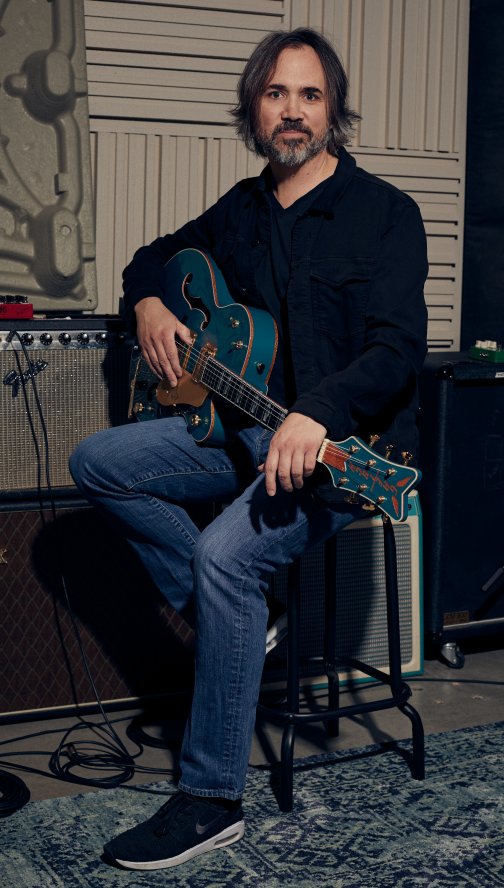
As you could probably guess from my name, I am somehow related to Bruce & Craig Hardy…and you’d be correct. I am the oldest son of Craig, and my owners’ story is a bit outside the norm of your typical owners’ stories, and can easily say that Silver Street and all the people involved changed the course of my life and career. I don’t want to drone on with every little detail but I would like to give a perspective of the ways Silver Street played a part in where I am today.
First of all, I’d like to say thank you and also apologize, at the same time, to all the employees who had to put up with me. I probably wasn’t a model employee, or even a good one. I think I was around 12 or 13 when I started working in the factory, so I think it’s safe to say I wasn’t exactly career driven at this point in my life. You also need to realize that we had been making trips to Elkhart, IN as a family years before the eventual move of the factory to Shelby, MI, so there wasn’t exactly the excitement of a “new car smell” to the factory. It was more like how long would it be before my sister and I got into trouble while waiting at the factory.
My first Silver Street was a full-size cardboard cut-out of a taxi with a technical drawing taped to it. I could play the $#*! out of that thing, but unfortunately it could not withstand the ferocity of my chops and it ripped in two. My second Silver Street was a reject taxi, which I still own today, that had some funky glue joints, but it still played like a proper guitar. Keep in mind growing up around Silver Street allowed me to see some well-known and lesser-known artists play the guitars in person, as well as, seeing photos of the players on concert stages playing Silver Streets, and also looking at the backstage passes that came back home with my Dad. It was all pretty amazing to take in as a kid and definitely sparked the desire to learn how to play the guitar.
Learning to play… I’m not exactly sure how this went down, but I must have bugged my Dad to the point that he finally caved and agreed to let me build my own Tommy Shaw model, and then let me start taking guitar lessons. Enter Dan Mustard. Not only did Dan get stuck with walking me through how to build a guitar without shoving my hand in the band saw, but he also became my first guitar teacher. Wrap your head around that one for a minute, because I wasn’t joking when I said earlier “…all the people involved”. Honestly, I easily could fill a page about Dan without even trying, but the bottom line is he was a great mentor. A fantastic player, builder, and human being with an insane amount of patience, and he was one of the reasons I wanted to pursue music as a career. He taught me for years and gave me the tools I needed to move on to college and study music.
The last piece of the puzzle was the Steven Volpp Drum company. Steve was the VP at Silver Street when he launched SVD. Steven Volpp Drums were bought and manufactured by Peavey as the Radial Pro Drums. Without Steve I wouldn’t have been able to make the last jump from Michigan to California, so again, the people of Silver Street were a big factor in my story. Through connections from the sale to Peavey, I ended up playing in a band with the son & daughter of Peavey’s Vice-President, Jack Wilson. Being new to California and not knowing anyone except for the band members, I’d find myself hanging out with the Wilson family quite a bit. It was Jack who gave me a tip that a composing team was looking for help at their studio in Woodland Hills, CA. I got an interview and offered to work for free for a week as a sort of “audition”, and then the next thing you know it turned into a 25+ year career.
I’m fortunate that I get to work in film & television and create music. Now that I’ve spent the majority of my career playing, recording and mixing, I finally get to appreciate Silver Street guitars and what they can do in the studio as the end user.
For more information:
https://www.rocketsurgerymusic.com/
Interview: http://voyagela.com/interview/meet-troy-hardy-rocket-surgery-music-van-nuys/
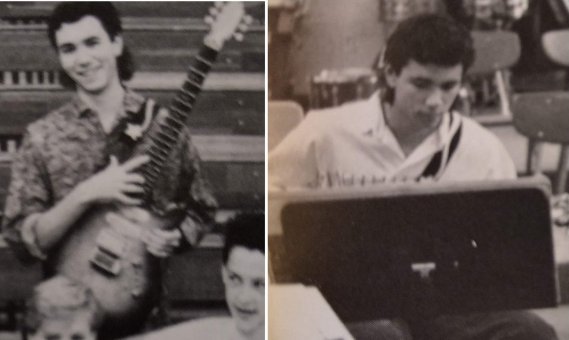
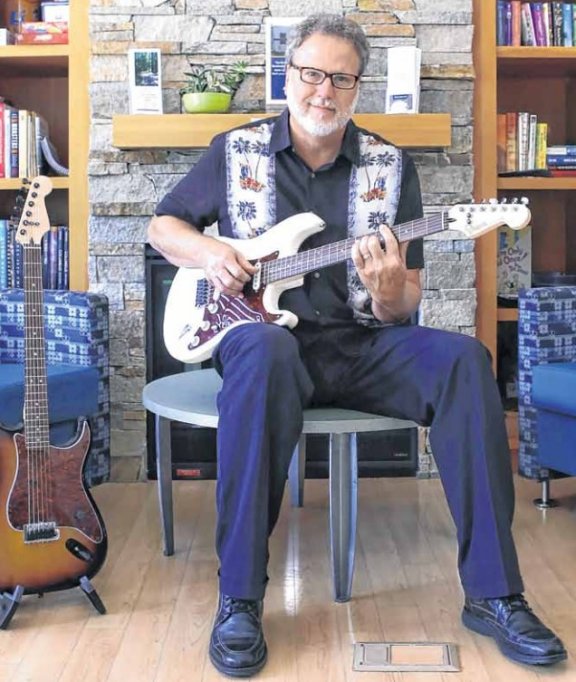
I grew up in Michigan, not far from the Shelby location of Silver Street Guitars. I began playing guitar when I was 11 years old and, due to the rural area where I lived, I learned how to do my own guitar repairs and maintenance. I moved to Kentucky to attend college after transferring from a local community college in Michigan. Following college graduation in 1982, I had taken a summer job as a house painter, and that lasted longer than I had anticipated. I did gain experience working with various stains and finishes, and more importantly, different types of spray equipment. My sister, who still lived in Michigan, sent an ad from the local newspaper that stated that a guitar manufacturer was seeking someone with painting/finishing experience. I submitted an application, and according to legend, a friend of the family twisted the arm of Silver Street owner Craig Hardy to call me in for an interview. I pestered Craig enough that I eventually wore him down and he gave me the opportunity to begin working at Silver Street in the late summer, early fall of 1983.
I had more enthusiasm than experience, but Craig and his partners invested the resources to bring in actual experts to do some training. Gibson had recently transitioned their manufacturing from Kalamazoo to Nashville, and there were several employees who did not want to uproot their families, and so they were available for consultation and training. I worked with Charlie Harrison, who had been a supervisor in the Gibson finish department. He gave me a master class in prepping, spraying, and buffing guitars in the Gibson tradition. I learned how to do solid finishes, pearls, candy colors, and traditional sunbursts. We even worked on pin-striping and custom finishes that were becoming popular at the time. (Think Eddie Van Halen stripes, tiger stripes, and geometric shapes.) It was an incredible, once-in-a-lifetime experience, and it was an amazing way to connect to the deep history of Gibson’s production finish techniques.
The basic steps to the finish process began with a finely sanded body, usually maple. We did a few bodies in exotic woods, and also did some mahogany bodies with maple caps in the Les Paul tradition. The bodies were filled, sealed and sanded. Then I would begin the process of applying the spray finish. If the guitar was going to be a standard opaque finish, I would spray the color, and then several coats of nitrocellulose lacquer. When I had sufficient coats built to protect the opaque, I would sand the clear lacquer in between applications. When I achieved the necessary depth, I would then wet sand the body to level the finish, and then would use a pedestal mounted buffing wheel to bring the finish up to a wet gloss. It would generally take a week or two to complete a finish, so I would have multiple guitars in varying degrees of progress at the same time. I would often do batches of similar finishes for efficiency.
Since we had a small production staff, (primarily Rick Woodbury, Phyllis Kidder, and myself) I also learned how to do final assembly and set-up. At the time that I started, we were contracting some of the sub-assemblies, but we quickly transitioned into doing everything in house. The team learned how to do all of our own manufacturing of bodies and necks, including fingerboards, fretting and all aspects of building guitars entirely in our facility. As others left, I took on more responsibility, including design work. Steven Volpp, our young and incredibly talented marketing manager, had cultivated a relationship with Tommy Shaw from Styx. Tommy was interested in collaborating on a signature model, and with his feedback and direction, we developed the Tommy Shaw model. Steven and I made several trips to Tommy’s farm in Niles, MI to deliver prototypes and discuss his preferences. One of the highlights for me was to see Tommy perform with one of his guitars on a MTV televised concert that was filmed at Notre Dame University.
We experimented with several other ideas, including a solid-body nylon string guitar that had a piezo film element laminated into the body. It worked too well, and the whole instrument was microphonic. I also designed a set-neck model that we called the Elite. This guitar really reflected all that I had learned as a guitar builder.
As Silver Street moved away from guitar production, I left the business and went to work in music retail, and eventually played music full time. I later worked in the field of disability services, and now I am the director of a large senior center in Indiana. I still build and play my own guitars, and I am incredibly proud of the work that we did at Silver Street.
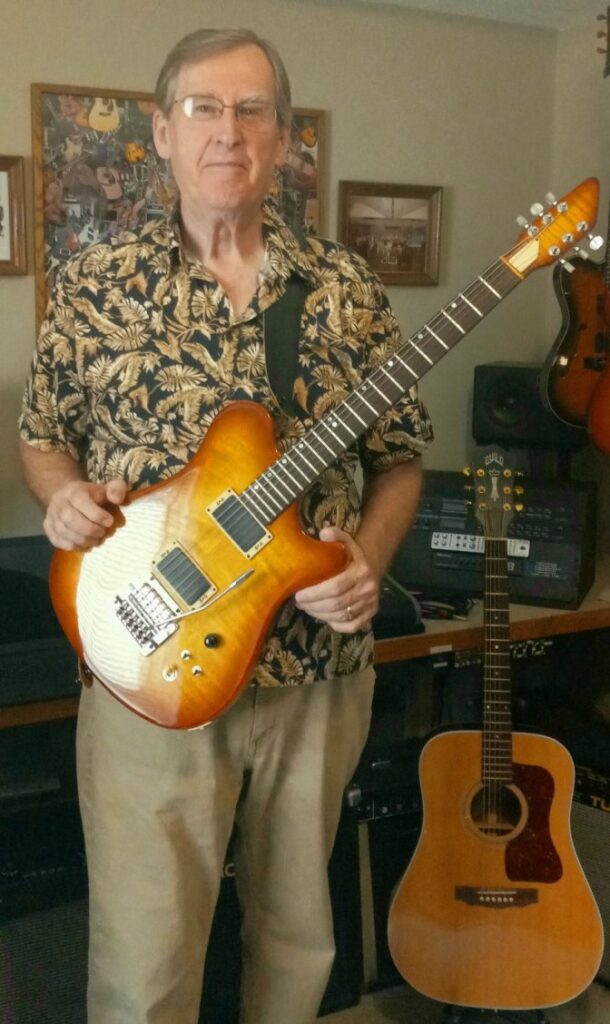
**********
I started working at Silver Street in January of 1986. I was teaching guitar at Instrumental Music in Ludington when Dan & Steve stopped by one night in December of ‘85 to show Jeff Nixon (the owner) a guitar they had just finished. Jeff suggested they show it to me. I was impressed by the quality and playability of the guitar and mentioned I had done some modifying on my own instruments over the years. This led to being asked if I would like to come to work at Silver Street.
My main job at first was to build wiring harnesses. I had acquired the experience with the wiring on jet aircraft during my stint in the Navy and also rewiring my instruments while traveling with bands in the 70’s. I used the same method of securing the guitar wiring that I had learned in the service. This secured the wiring so it wouldn’t be damaged if a pot or jack came loose. I believe it was called “stress proof” in the catalog but we dubbed it “Rock & Roll Proof”. During this time I also drew wiring diagrams for all of the instruments.
From wiring harnesses I moved on to all the other aspects of assembly and setting up the instrument. I learned so much from Dan about fretwork, finishing, set ups, and quality control. I feel very strongly that what I learned during my time working with him at Silver Street was the ground work for me being able to do what I do today. I have been repairing and restoring instruments since I left Silver Street in the summer of 86. I started a repair business while working at Kik N’ Associates Music in Grand Rapids, Mi. in November of 1986 and have been doing it ever since.
I moved to Branson in January of 1996 with my wife Paula and our son Daryl and started M.R. Stringed Instrument Repair. During the last 26 years I have been privileged to work on instruments for some country music legends. I have repaired and restored instruments for Roy Clark, Johnny Lee, Larry Gatlin, Janie Fricke, Mel Tillis, Buck Trent, and several members of The Sons of the Pioneers. I restored the guitar that Jimmy Rogers used on his hits “Honeycomb” and “Kisses Sweeter than Wine” and the acoustic guitar used on the recording session “Waltz Across Texas” with Ernest Tubb. I also have been able to do work for and become friends with many of the musicians in Branson who, in my opinion, are some of the best anywhere.
I will always be grateful for the time I spent at Silver Street even though it was short (January to June ’86). Working with Dan & Steve and the rest of the crew was one of the best experiences of my life. It would have been great if we could have made it last longer. I have my special Silver Street guitar and yes, like all my instruments, it has been modified (I can’t seem to help myself). I am sure there is a lot of music still hangin’ around on those strings!
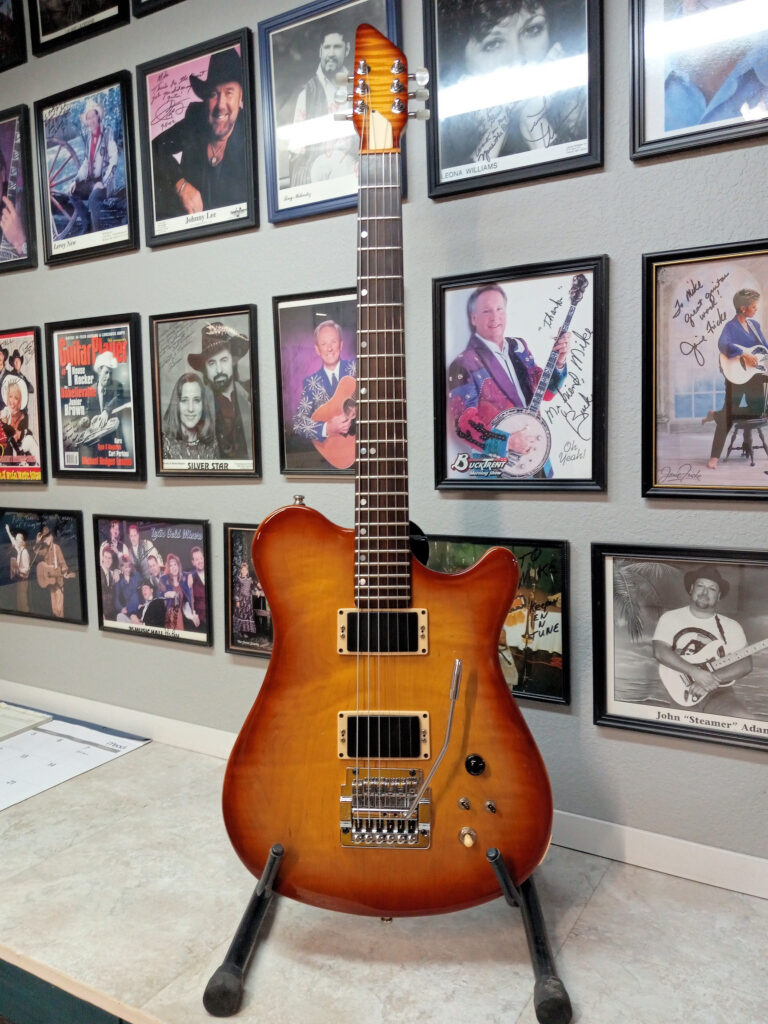

I worked at Silver Street from 1983 to 1985 when I was in my twenties. I worked with Dan Mustard, Mike Ristau, Rick and Robert Woodbury, Jeff and Debbie Anderson, Doyle Bermister, guitar sanding expert Phyllis Kidder, secretary Jodi Stark and others.
Bowling was a demonstration sport at the 1988 Olympics in South Korea, so we made products for Brunswick as it expanded its network of US bowling centers. They included ball racks and pit planks. I made black walnut “darts” that were inlaid into the alleys. We made trim pieces for DCM Speakers in Ann Arbor and light enclosures for the Dunkin’ Donuts and Dandee Doughnuts chains. We also built maple silk-screen frames for a Grand Rapids company.
I operated wood shapers and other machines. I learned finish spraying and built the second paint booth. I also helped set up an overhead belt sander and participated in various other projects.
My time at Silver Street was a wonderful learning experience and I gained considerable knowledge while working there. I still have the Taxi model shown in the photos above that I assembled for myself.
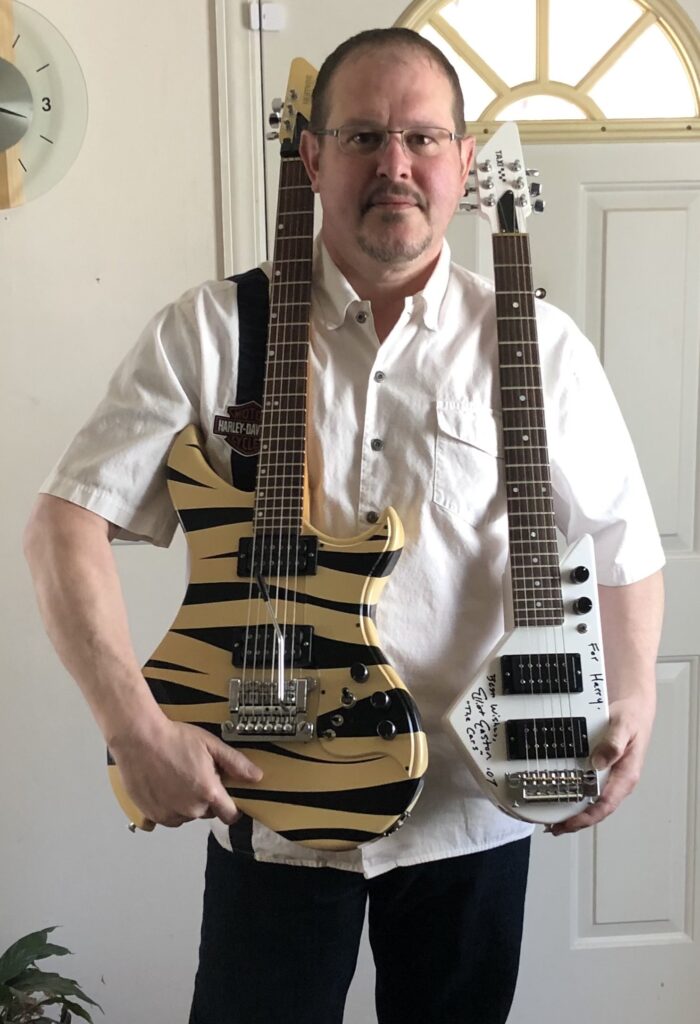
****
I want to start by thanking Murray for all of his hard work with creating the Silver Street website. You left no stone unturned with your quest to know everything you could possibly learn about these fine instruments and the history of Silver Street guitars. I appreciate all of the great memories that this website has brought me!
I grew up very close to Shelby and the Silver Street Company. My mother worked there when I was in my teens and I was able to spend some time at the factory. It was amazing to watch the incredible people make the guitars at every step of the process. I remember being in awe of everything that was going on at Silver Street. I also remember going to Notre Dame University with some of the employees to see Tommy Shaw play his signature Silver Street guitars live in concert!
My first experience with trying to learn guitar didn’t go well. I was loaned an acoustic guitar and a chord book and was left on my own to try and make sense of it all at the age of 13. After a few weeks I gave up because I couldn’t get a chord to even sound slightly musical! Fast forward a couple years and I saw Elliot Easton and The Cars on MTV…I was playing a right handed guitar and there really WAS such a thing as a left handed guitar! This was a revelation for me and I knew that someday I was going to try and learn the guitar again but with the proper dexterity axe for me!
As the years went by I did find left handed guitars and I did start learning how to play the guitar. I also realized quickly how hard it is to find good left handed guitars. I always remembered the times that I spent at Silver Street but the internet wasn’t available for me until the late 1990’s and that is when my search for a left handed Silver Street guitar began. I searched, and searched, and searched, until I finally found a right handed Gold Top Taxi in 2004-2005. I had to buy that Taxi because I figured I may never run across another Silver Street guitar let alone a left handed Silver Street. Then in 2007 I learned that Silver Street did in fact make one left handed guitar…a Taxi model that was built for none other than Elliot Easton himself! Fortune came my way when I ran across Mr. Easton on an online forum and, with the help of the forum Administrator, I was able to contact Mr. Easton and purchase the Taxi directly from him! When I received the guitar I was blown away with the impeccable condition the guitar was in…how lucky can a guy be! I finally had my guitar treasure and decided that I needed to let go of the right handed Taxi. I wasn’t going to let it go to just anyone, however. It had to go to Murray because he felt the same way that I did about Silver Street guitars.
I also became the proud owner of a “Craig Chaquico/Ted Nugent” painted Nightwing a handful of years ago when Murray started downsizing! It’s a righty so I can’t put it through the proper paces but I will cherish it just as I do my Taxi. And then, to top all of this off, last year I learned that the Gold Top Taxi that I purchased years ago went to Tim in Manistee, MI and it became the missing link in a Trifecta…and it’s named Harry! I am so honored, Tim, thank you sincerely!
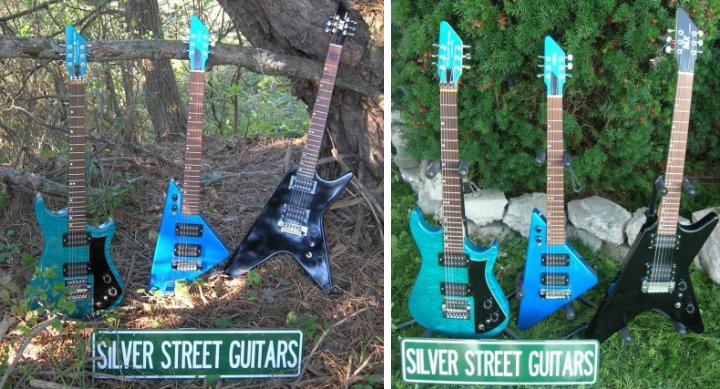
He had a passion for music and was known throughout the music industry as one of the best sound engineers in the business. The story of RD’s acquisition of these Silver Streets is unknown. Thanks to Alpha Music in Virginia Beach for facilitating the relocation of these instruments. The trio is now with Tim, an appreciative Silver Street collector in Michigan.

I remember first hearing about Silver Street guitars in the early 1980’s through little ads in the music magazines. They were made in Elkhart, IN. In mid-1983, the factory was relocated to Shelby, MI; a town near my hometown. Around 1985, my local music store became a dealer for Silver Street guitars. If memory serves me right, I remember a couple Taxis, a couple Nightwings and a sunburst Tommy Shaw model.
My guitar-playing friends and I were very impressed with these guitars that were built in our backyard but, working as a busboy, I just couldn’t take the plunge. It was a great time back then as Shelby is near Mears, MI where we had all the big rock concerts at Val Du Lakes Amphitheatre. We would always ride past the Silver Street factory on our way to the rock concerts. What was really cool was a lot of pro players were turning up with Silver Street guitars. I remember seeing David Huff with the Christian rock group David and the Giants at our local Armory putting a beautiful white Spitfire model through the paces.
A few local musicians were using Silver Street guitars. I remember seeing a local guitarist by the name of Leif with a beautiful burgundy Nightwing with Kahler Tremolo being played through a Peavey Renown 2-12. That Nightwing sounded amazing and really turned me on to what a Silver Street guitar was all about. The Nightwing weighed a ton but played like a dream. To this day, the Nightwing is my favorite model due to this first encounter.
I went along my musical path with the popular Fender and Gibson wares but always kept Silver Streets in the back of my mind. Fast forward about 25 years and, while surfing the internet, I came across the great SilverStreetGuitars.com website. My youth came flooding back. I thought that maybe I should find a Silver Street guitar to relive the old days. After looking for a few years and studying the website, I finally found a Silver Street guitar I was interested in on Craig’s List. It was a single pickup Sunburst, gold hardware, perfect condition Spitfire model from a great lady Dawn in Grand Rapids, MI. After the purchase, I thought the search was over but little did I know it was just beginning.
After seeing what a great guitar the Spitfire was, I decided I probably should have one of all the seven models. I didn’t think it was possible as some are super rare and very hard to find. With some help from a special dude and good friend I was able to accomplish that goal. Every time I pick up one of my Silver Street guitars it takes me right back to high school when the world was a simple place and I was going to be the next rock star. Everything about these guitars says 1980’s; pointed headstocks, Dimarzio pickups, Kahler and Floyd Rose Tremolos. I would highly recommend trying one for yourself. “Designs of The Future – Today”. A very special Thank You to my dear friend Murray, the guru of all things Silver Street. He has been so very generous and kind with all my questions and inquires through the years. Thanks for keeping Silver Street guitars and the dream alive. Tim.
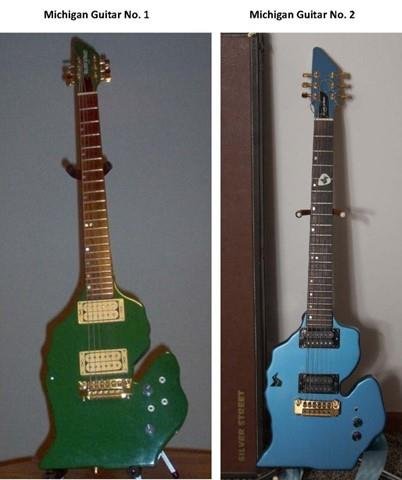
He sent this backstory: “I was teaching beginner guitar lessons at Bird’s Music in Muskegon, Michigan. It was somewhere around 1986. I came out of the lesson room and it was out on the floor sitting in a guitar stand. It had a price tag of $150. The store owner said that a guy traded it along with some cash in exchange for a keyboard. I immediately asked the store owner how much cash I would have to fork over to make sure it didn’t leave the store with someone else. He countered with “How much you got?” I had $40 on me. It was enough.
For the next few months a portion of my lesson money went to pay off the guitar. I have had it ever since in spite of many offers to purchase it from me. I visited the factory in Shelby, Michigan many years ago and the story they gave me was that it was one of three specially built instruments that they took to the National Association of Music Merchants show that year. The guitar is a pretty good playing and sounding guitar, but not one that would knock your socks off. In fact, the pickup selector switch is actually wired backwards compared to the typical wiring. On this guitar the bridge position is up and the neck position is down. I never fixed it.”
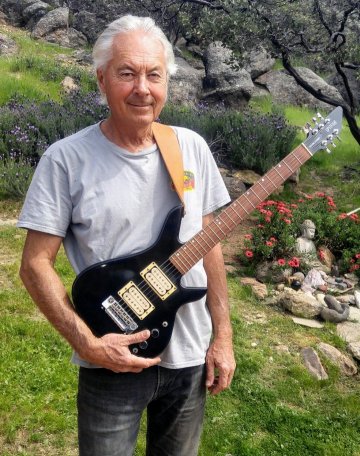
Here’s John’s fascinating story: “I bid on and won this wonderful Silver Street at a charity auction in 1995 (I think). Chris Hayes of Huey Lewis and the News donated it to the cause. I think I was the only guitar player in the crowd because I was the only bidder! Anyway, I was lucky and subsequently became friends with Chris. He told me that he had written one of their hits “I Want a New Drug” on this guitar. As a result of the Oct. 2017 Northern California wildfires I lost the original case and accompanying documentation. But fortunately I had the guitar packed in a soft shell case stashed at a different house, so it’s safe and sound. I still play it.”
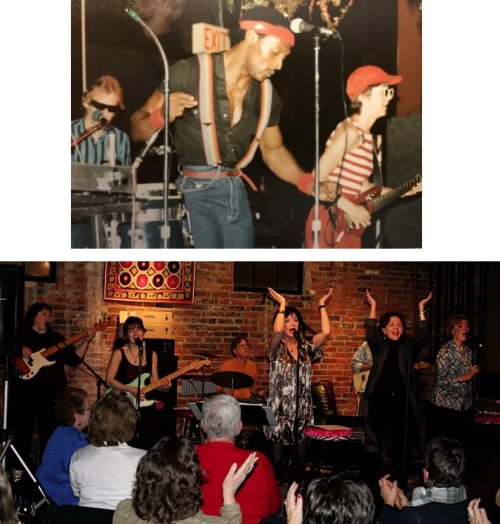
“The moment I saw a counselor playing a ukulele at Girl Scout camp in 1965, I was hooked. I taught myself to play uke and guitar and played the rest of my life. Things took a turn towards the electric guitar in 1975 when my boyfriend and future husband asked me to sit in on a few songs in his band. With Nancy Wilson of Heart as my role model, I started playing with the guys. In 1978 I studied jazz guitar in New York and was ready to be the sole guitarist for two of our bands. In those bands I used a custom Les Paul that was so heavy I began looking for something lighter.
That’s when I saw the Taxi and loved it: obviously lighter, cooler looking and it fit right in with our 1980’s, MTV style band. I had it customized to switch from single coil to double coil pickups; it was a workhorse for our cover-band material. I retired from playing after the birth of my first child but continued to write and record in our home studio. In 1998 I was a founding member of a comedy/cabaret group called The Bats, writing quite a few of our comedy songs. In that band I used my ’57 re-issue Fender Strat. I was with The Bats for 16 years until I finally retired from playing in 2014. Now my plans are to write a book and a musical–we’ll see!”
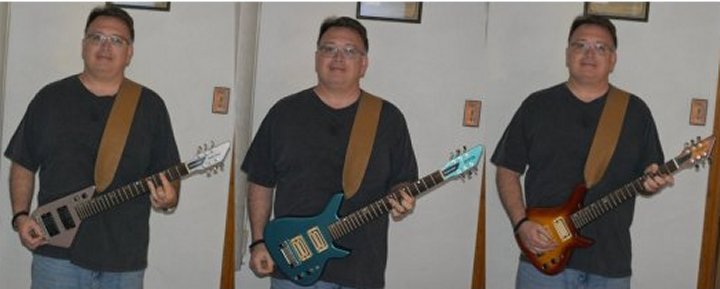
* * *
I started playing guitar in 1978 when I was 11 years old. All I really ever wanted to do was play a little bit on the weekends and have some fun. What actually ended up happening was not my plan, but the Almighty’s. I was not able to get into the bars to play my gigs because of my age, so my European grandfather, who most certainly would have preferred Eine Kleine Nachtmusik to Inna Gadda Da Vida, always took me to my gigs. He did it because he loved me, and even though he has been gone since January 1986, I miss him every day.
So what actually ended up happening is that since 1978 until present day, I have never not been in a band. I played all through high school, college, when I was in the military, a student in Europe and South America and to this day. I did have a golden period of about 20 consecutive years playing on average 120 gigs per year. I never made my living from just gigging, but almost; and I am at least an extremely seasoned musician. When I look back on it, all I feel is gratitude. Sheer gratitude. I am so thankful.
When I was a kid, I didn’t have much money, but I was always able to buy the Guitar Player’s Buyer’s Guide. I remember seeing a Taxi ad and thinking WHAT IS THAT?????!!! The next thing that happened was I saw Don Barnes playing a white Spitfire. I was hooked. The Spitfire is my favorite Silver Street, and even though I have never had an opportunity to buy a white one, maybe one day. In any case, what I already have is great.
What I will say next is my opinion. If you agree with me, OK. If not, OK. At that time, companies like Silver Street were looking at what was available in the marketplace, they were implementing their ideas and innovating. Sadly it is a time that will never come again in my opinion. Now you basically have a couple of options. Maybe 1000 luthiers worldwide who make fancy Fender copies. Guitars of many different brands that are all made in the same factories in Korea and China. Extremely expensive guitars with fancy wood and electronics. Perfect in every way but not much on innovation. And the Made in USA expensive traditional brands. The only brand that has never sold out is Rickenbacker, and I appreciate them for it. No, a company like Silver Street will never come around again, but thankfully they came around once and we appreciate what they tried to do.
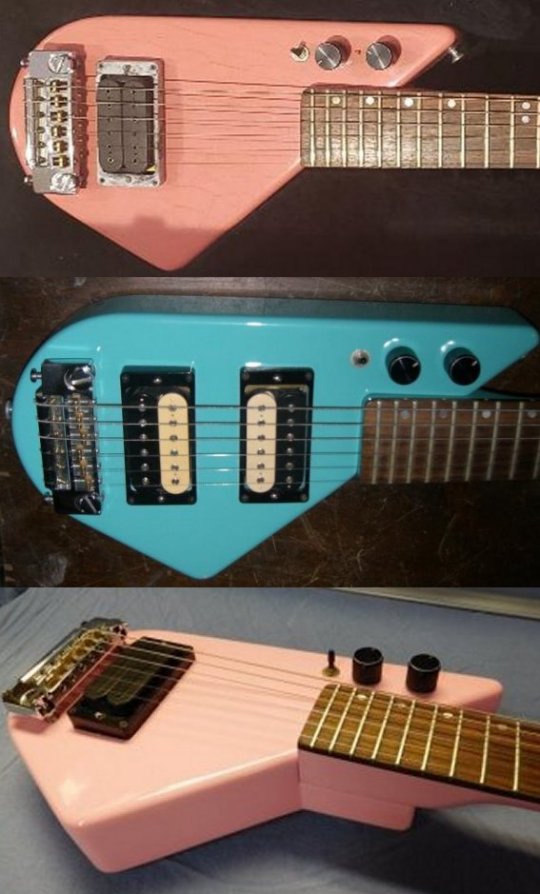
What are the odds? From the webmaster’s collection:
Taxi T-043154, Rose Pearl
Taxi T-043155, Teal blue
Taxi T-043156, Pepto-Bismol

* * *
Turquoise Taxi T-108. This is the first Taxi I purchased and one of many that I own. In 2015 I was put in contact with Bruce Hardy, the founder and visionary of Silver Street Guitars, who had this beautiful Taxi for sale. I had a “Field OF Dreams” moment as I met Bruce halfway between my home in Michigan and Bruce’s home in Indiana. Bruce and his wife were most gracious to me; he answered my questions about Silver Street guitars and signed a couple of guitars I brought along and a Silver Street sign. I was able to get a great picture of Bruce and me with the Taxi and my turquoise Spitfire model which is posted on the Taxi page. This is a great guitar that sounds and plays like a dream with a great matching set of cream Dimarzio PAF pickups. This Taxi is all original with the original case and both are signed by Bruce. All the available case candy is included. It’s one of my favorite Taxis and a great memory, too.
Yellow Taxi T-109. I knew when I started collecting Silver Streets I wanted an original yellow Taxi. In 1981, while still in high school, I would see this guitar in advertisements in music trade magazines as Silver Street Guitars was being launched. This is the guitar that started it all for Silver Street and usually the first model I think of when that name is mentioned. This yellow one comes out of the famous Murray collection and is truly a beautiful example. It is a single pickup version with a well-rounded Dimarzio Super II pickup that is very versatile for any style of music. This Taxi is very responsive with sweet overtones all through the range; a truly magical guitar. It is all original with hard-shell case and case candy. A big Thank You to Murray for letting me be the caretaker of this magical guitar.
Gold Top Taxi T-110. For guitar collectors, it is very unusual to find two guitars with consecutive serial numbers. Having a trifecta of three is almost unknown. This is another beautiful Taxi from the Murray collection. Again a single pickup version; this one has a cream Dimarzio PAF. It’s one of the best condition Taxis I have ever seen. My friend Murray knew that I had T-108 and T-109 and that I needed T-110 to complete my Taxi Trifecta. I told him I would purchase this Taxi from him on one condition; the Gold Top Taxi would always be known as “Harry” as a tribute to Harry from Kalamazoo who kept it in impeccable condition for many years. Murray agreed this would be a fitting tribute. “Harry” is all original with original case and case candy. A big Thank you to Harry and Murray for really caring for and preserving this cool little Taxi; I will try to make you proud.
What next? If I could find Taxi T-107 or T-111, I’d have a Taxi Quattro. Here we go again. The Taxi … highly innovative and ahead of its time; try one today! All the best. Tim.
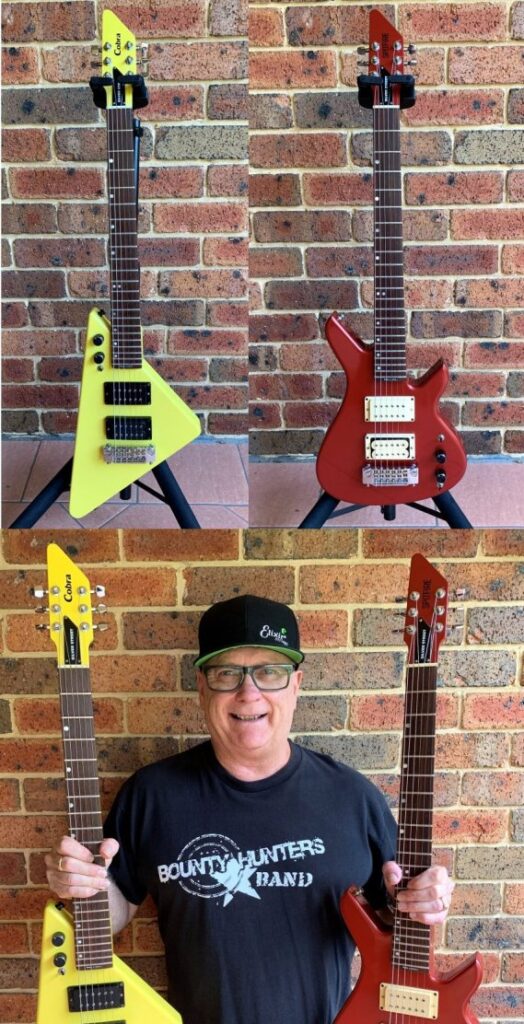
My Silver Street Story
By David Hinds – Lake Macquarie, Australia
Owner – Silver Street Spitfire Serial #S009 and Cobra Serial #C92013
Between 1982 and 1985 I owned and managed a music store, Oasis Music, in Port Macquarie, a beachside tourist town on the east coast of New South Wales, Australia. We sold the usual selection of musical instruments but, being a guitar player myself, the store’s accent was on guitars, amps and pedals.
One day the rep from one of our suppliers, Billy Hyde Music, visited the store to show me the new line of guitars they were importing from the States, Silver Street Guitars. He had the Spitfire and Cobra with him, and I was very impressed with the workmanship and sound, and also the unusual shapes. Plus, they retailed at AU$450.00 including case, at the time, which I thought was great value for a US made guitar with DiMarzio pickups, which were hugely popular. And they were very different to the usual fare of Fenders, Gibsons, Ibanez and Washburns that we were carrying, so I bought both of them to sell in the store.
They created quite a bit of interest, but didn’t fly out the door as I expected them to do. Maybe they were just a bit too radical for my mostly conservative clientele. I may have had more chance of selling them had I been located in a major city. Anyway, as fate would have it, the demand for my recording services started to outweigh the retail side of my business, so I closed the store in 1985 to open a professional recording studio. As the Silver Streets were still in stock, I kept them for myself, and I am so glad that I did.
They have given me much pleasure over the years, and every time I bring them out to play with the band, they always raise a few eyebrows! I love my Spitfire and Cobra, and they are definite keepers!
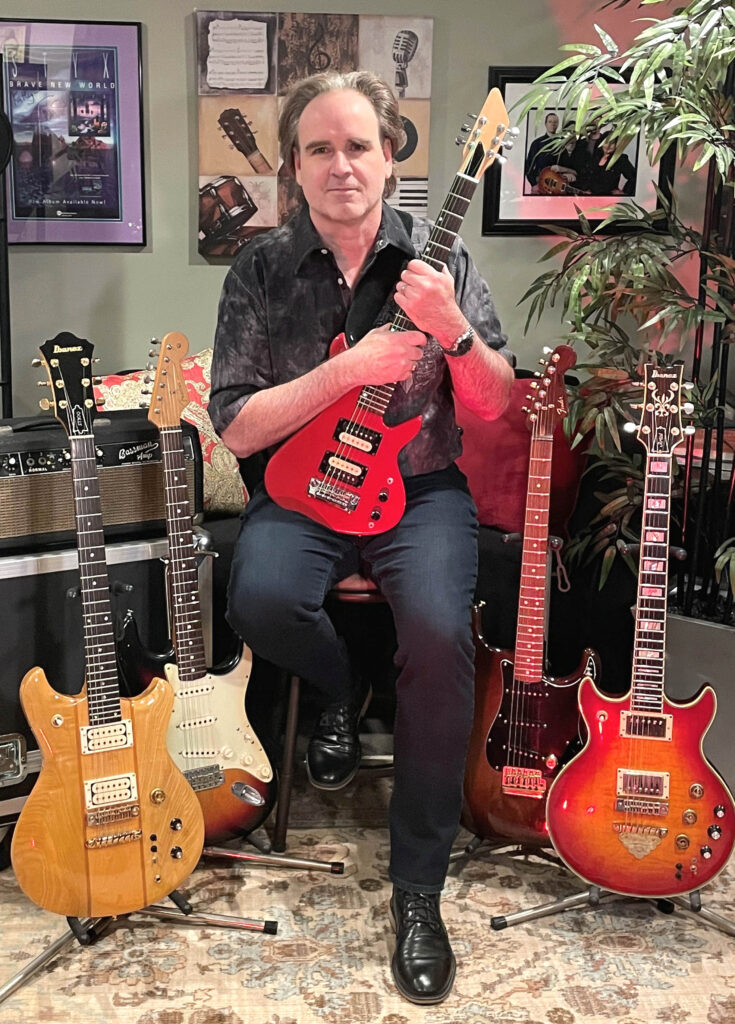
Visit Katalyst Band website here: https://katalystband.com/
My Silver Street story goes all the way back to 1984 when I was 13 years old and the new STYX album ‘Caught In The Act’ had been released (a live recording of their 1983 ‘Kilroy Was Here’ tour). I had just discovered STYX a few years earlier with their ‘Paradise Theater’ album and I was instantly a fan. I was also vaguely aware of guitar becoming a bigger influence/hobby in my young life. I really knew nothing about nothing (in terms of gear) at the time, other than I was intrigued by it, and was able to plunk out a few notes and rudimentary chords to play along with a couple of STYX songs on an old beat up classical guitar that my mother had.
With the new STYX ‘CITA’ album, I pored over all the live shots of the band included in the album packaging. I already knew that James JY Young primarily played a mid-60s Fender Stratocaster and could see pics of Tommy Shaw with a Strat (an early 80s Walnut ‘The Strat’ in fact…!) and a Martin acoustic, but I was curious about some of the other axes were that they were seen playing. Eventually, I figured out that JY was also playing an Ibanez ST-200NT (yes, I own one because of him) and Tommy was using an Ibanez AR-500CS (yes, I own one because of him), but there were two pictures of Tommy with a small-bodied guitar that I absolutely could not make heads nor tails of. One of the pictures (Photo 1 below) was on the back of the album cover which was a cropped shot showing just the upper bout of the guitar and part of the neck humbucker pickup. The other picture (Photo 2 below) was a somewhat low light, blurry action shot of Tommy on the inner album artwork which showed the whole guitar body with two cream colored humbuckers, but the headstock was indistinguishable.
Remember, there was no ‘interweb’ way back in 1984-85, so the best I could do was to try and cross-reference against the two or three copies of Guitar Player magazine that I had at the time. That was about it, the extent of my research, which yielded no answers. For years, I thought it might be a Yamaha of some kind, along the lines of an SS or SC model, or some other off-beat, off-set body Japanese manufactured guitar of the time. But with the limited information at my disposal, like many other manias of our salad days, it was eventually forgotten and life moved on…
Fast forward a few decades (“Got a good job, got a good office, got a new wife, got a new life, and the family’s fine…”), and with the advent of the interweb and eventually great resources like the Silver Street Guitars website created by our friend Murray, I quite unexpectedly stumbled onto the long awaited answer to the Tommy Shaw mystery guitar question from my youth. Now, I first found Murray’s site looking for information on the Silver Street Tommy Shaw model guitars (well duh…) which I had also lusted after back in the day. I was quite ecstatic to see the number of pictures and all the cool reference information that was available regarding these guitars. Suffice to say that thanks to Murray, a couple of TS models have found their way into my collection (I mean, my wife Kathy’s and mine; she’s a HUGE STYX memorabilia collector too…).
Once I exhausted myself with the Tommy Shaw model content, I started poking around the other areas of the website, checking out the other Silver Street models: Taxis, Cobras, Nightwings, Spitfires…hey, wait a minute!?! Something stirred in the deep recesses of my memory. That Spitfire sorta looks like…Nah, it couldn’t be? Could it?!? Well, I’ll be damned. It was actually a photo on the Spitfire page (Photo 3 below) that made all the tumblers click into place. Seeing that photo made me sprint downstairs to get my copy of CITA and after about 30 years and 2 seconds, say definitively “Yep, that’s it. THAT is what Tommy was playing.” Maybe it was the red finish paired with the cream humbuckers, maybe it was the distinctive shape of the upper bout, coupled with the unique Gibson Victory styled dot inlays. Whatever it was, it clicked.
I have to thank Murray for curating this special little corner of the internet as well as the many contributors who have shared their pics and stories about this cool brand of ‘boutique’ guitars, back in the day before ‘boutique’ guitars were even a thing. Thanks for helping me solve this puzzle. It only took 30-plus years…oh yeah, and I also bought a red Spitfire (refin, serial number not available) from Murray to really close the loop on the issue! Not quite like Tommy’s but close enough!!! That said, I’m interested if anyone has one available (any color/PU configuration) for sale. Great little guitars, but you already knew that…
Post script: Of course nowadays, you can find EVERYTHING (good and bad) on the internet in a few seconds. Oh, how did we all survive back in the days of dial telephones, no cable TV, no bike helmets, walking to/from school, etc.?? Anyway, here are two CONCLUSIVE photos (Photos 4 and 5 below) from my collection of Tommy Shaw playing his red Spitfire back in 1983 on the STYX ‘Kilroy Was Here’ tour. Why couldn’t these have been included in the album artwork?!? Enjoy!!!
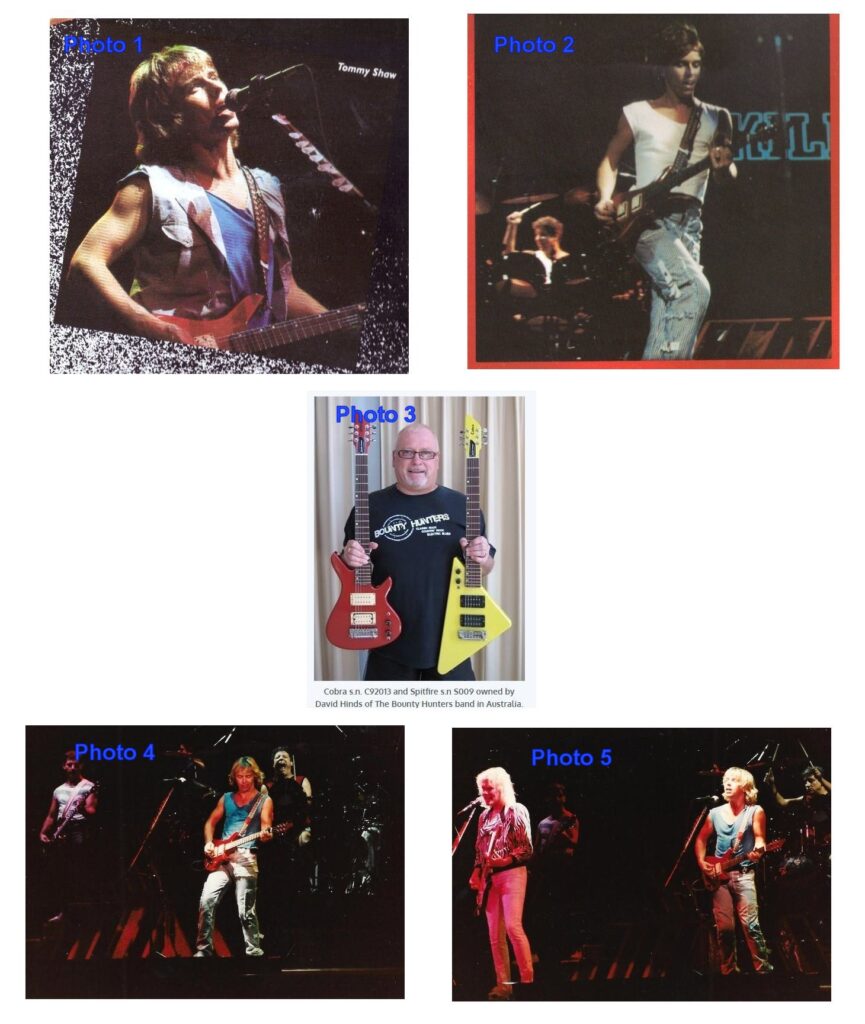
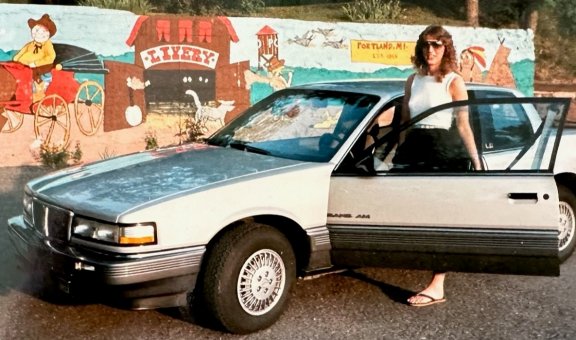
This great Silver Street story was submitted by Dodie Stark, a busy real estate agent. As her story below explains, Dodie was a multitasker who performed a number of vital roles in the company’s Shelby, MI operation.
Dodie’s Story
I was the Office Manager at Silver Street in Shelby, MI from May 1986 to Oct 1988. My duties included purchasing for the industrial and musical lines, accounts receivable and payable, sales and management of the musical line and business guest reception.
When I started, Craig Hardy was President with Steven Volpp as Vice President. Guitar production was winding down. The guitars hung on the wall in the reception area were played by visitors and employees.
DeadRingers were the main product and they were very popular. My husband was the drummer in a local band called Intense and he loved the product.
Other products included Headkeepers, Pick Clips, microphone standoffs and other unique guitar and drum items. We also produced slat seat parts for the Humvee and pit boards for Brunswick.
When Steven Volpp departed, David Thomas became the Vice President. Dan Mustard worked there and was a great guitar player. I also remember Rick Woodbury, Steve Standfuss, Phyllis Kidder, BJ Anderson, Debbie Anderson-Stuhan, Duane Stuhan and Doyle Burmeister.
It was a great experience working at Silver Street.
***
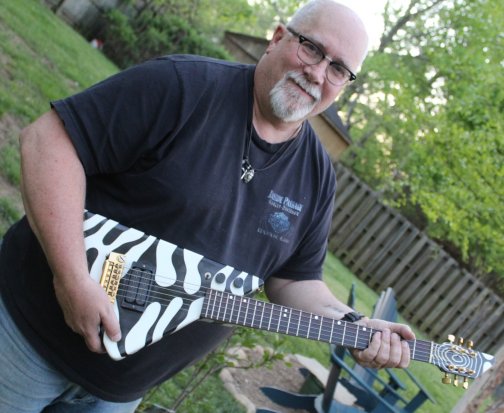
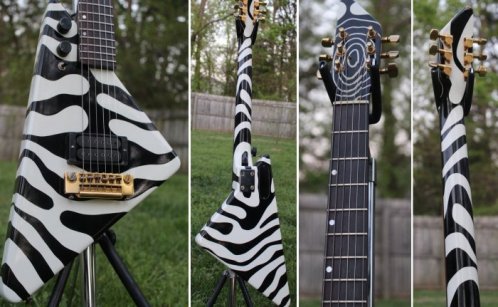
*****
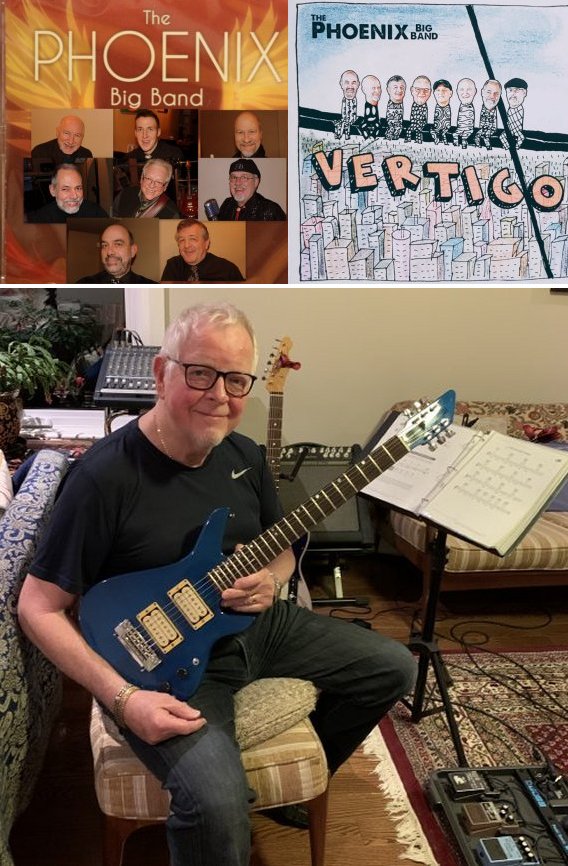
A great guy, a wonderful friend and a talented musician. This is Louis Weatherhead with his lovely blue Silver Street Spitfire (s.n. S-053039). A member of many bands since his teenage years, Louis is the lead singer, guitarist, bassist and driving force behind the Phoenix Big Band. It’s a very popular eight-piece blues group comprised of members with various professional careers. The group performs frequently to raise funds for charity. Two of the band’s self-released albums can be seen above. “Phoenix Big Band Live” was released in 2012. The band’s most recent CD “Vertigo” features 13 original blues tracks. Their live performances promise “No cover charge, no cover songs just great original music!” and attendees are invited to bring donations for the Ottawa Food Bank.
*****